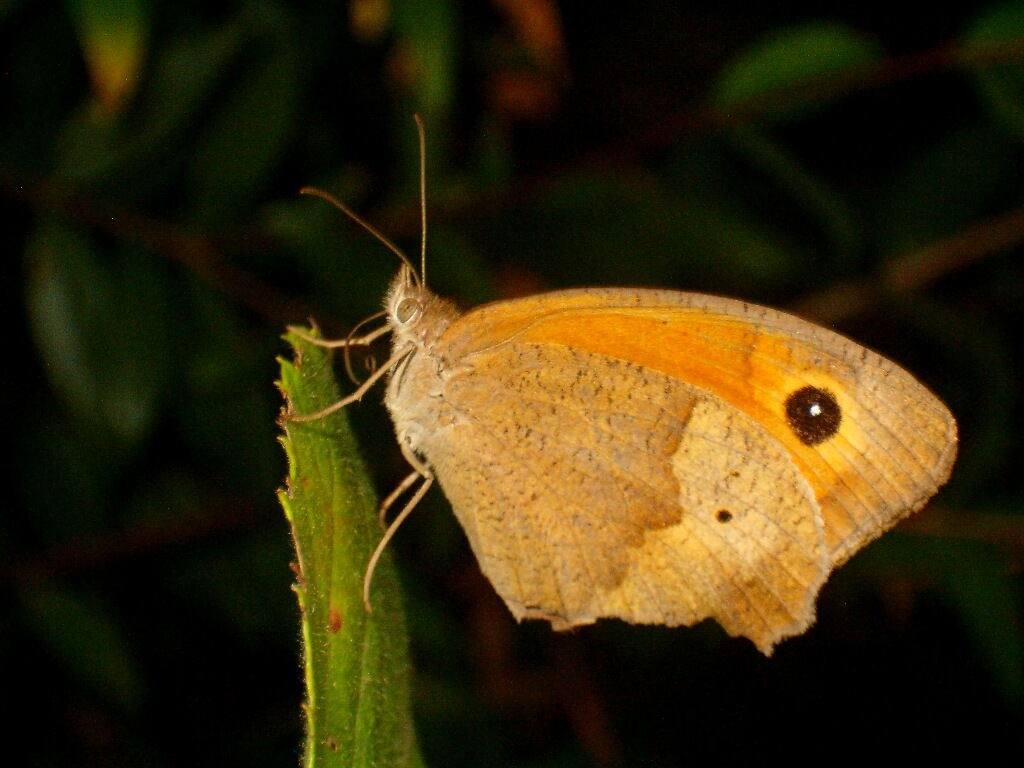
Butterflies in the form we usually know them, the adult stage (Figure 1), able to fly and reproduce, live a short time and every year their appearance depends on the prevailing weather conditions. For this reason many and consecutive visits to each habitat of the island are necessary for species identification.

Generally, butterflies cannot regulate their body temperature, and so they rely on the ambient by collecting sunlight so that they increase their own temperature. The dark brown color of the wings surface in some butterflies species, such as Hipparchia volgensis delattini (Figure 2), an endemic species to Europe, detected on Mount Roudi within Aenos National Park is believed to help accelerate the temperature rise of the insect body, as sunlight is rapidly collected so that the butterflies remain active for a shorter period of time. Besides, butterfly forest species Pararge aegeria (Figure 3), successfully competes with other species for a few rays of sunlight when enters from the glades and the foliage of Kefalonian Fir trees.
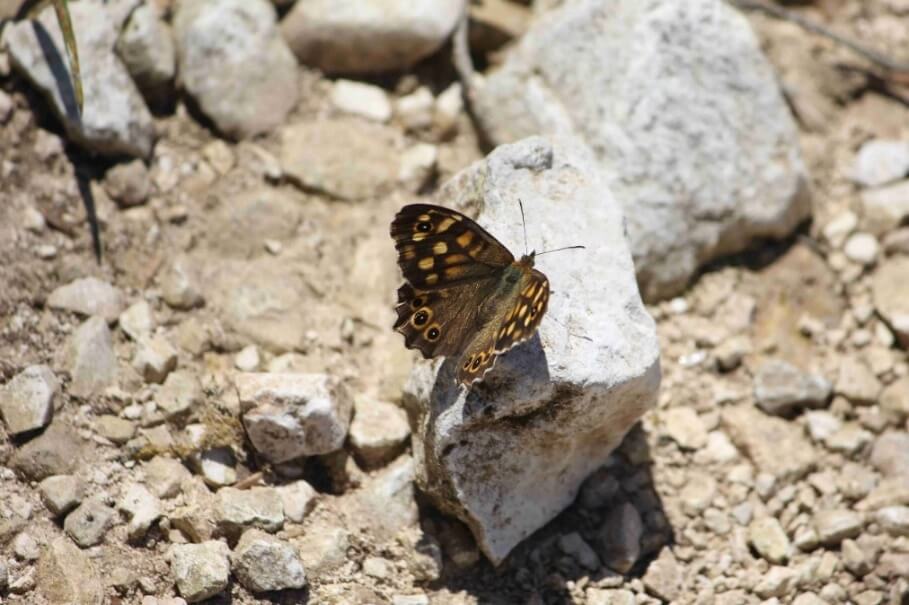
By sunset, butterflies complete the cycle of daily activities and choose a suitable place for a shelter to spend the night in suitable places like rock slits, leaves bottom, flowers, bushes shoots, tree trunks or even the ground. Butterflies of Lycaenidae Family usually spend the night onto a shoot with their head hanging upside down. All species close their wings to prevent that night moisture spreads to the wings surface (Pamperis 2009).

When butterflies mate, they remain attached as a single body for a long time and do not separate until fertilization is complete. The unusual long time of mating is explained by the fact that males make a corneal protrusion in the lower part of female's abdomen, which prevents the female from mating a second time. This protrusion is called "sphragis" from the Greek word seal (Pamperis 2009). In Kefalonia, mating procedure was recorded for the first time, on individuals of the species Vanessa cardui (Figure 4) detected on the island during the summer months. Some individuals of the species are observed in Kefalonia in January of next year, so it seems that these individuals do not derive from Africa during annual migration, but from eggs laid, and caterpillar and pupae grown in Kefalonia (Maroulis & Xanthakis 2015).
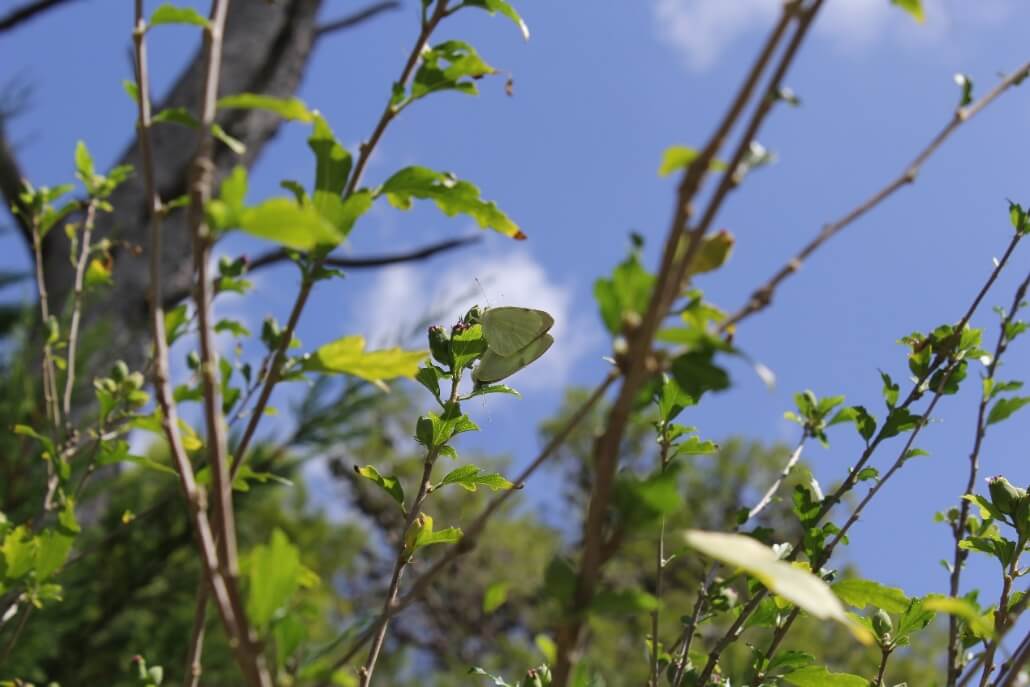
Two white-yellow butterflies of species Pieris brassicae mate on a bush in Koutavos Lagoon (Figure 5). They are both white yellow with shaded brown-black rib nerves. These wing nerves or ribs among other things contribute to the mechanical stability needed to fly. Nerves touch the two membranes forming the upper and lower surfaces of the wings and covered by fury shaped like "scales". Lepidoptera is a name given by scientists to butterflies and moths because of the characteristic "scales" on their wings. Each scale has a different color genetically determined at a species level and even at an individual level (among butterflies of the same species) so that different patterns of colors and marks are formed on the feathers of each species (Pamperis 2009).

Butterflies, like all insects, are closely related to their space and "habitat" (Figure 6), but also to the "host" plant onto which their caterpillars feed. Many butterflies use as "host" plants, different species of flora (genus Urtica sp, Lonicera sp, etc.) to deposit their eggs, except of the ground. When small larvae (caterpillars) emerge, they will feed on the leaves of plants and get transformed into pupae first and a year after to perfect individuals of the adult stage, the butterflies (Pamperis 2009).
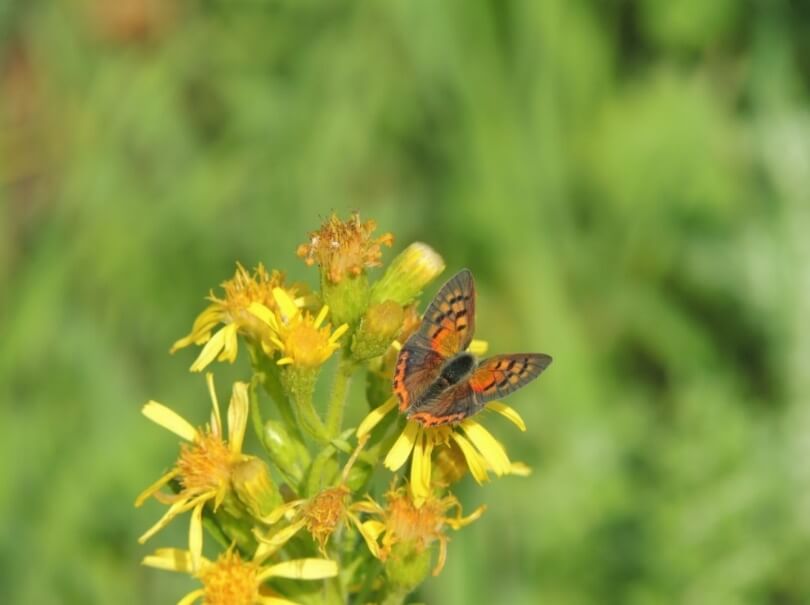
The group of Lycaenidae family butterflies sucks nectar by immersing their proboscis into tubular flowers (Figure 7). In this way they favor the fertilization of flora species, as they transfer the pollen from the male to the female organs of the flower. In the flowers of the species Thymus holosericeus in Mount Roudi of Aenos National Park, during the summer months gather many different species of butterflies such as the fancy butterflies species Argynnis paphia, Gonepteryx cleopatra and Iphiclides podalirius. On the foliage of Quercus coccifera shrubs are observed whole flocks of the butterfly species Neozephyrus quercus; in Kefalonia meadows the following species are detected: Lasiommata megera, Lasiommata maera, Colias croceus, Spialia orbifer, Satyrium ilicis, Lampides boeticus, etc. Due to chromatic imitation, species Hipparchia syriaca, Hipparchia fagi and Hipparchia statilinus are difficult to be distinguished from tree trunks.

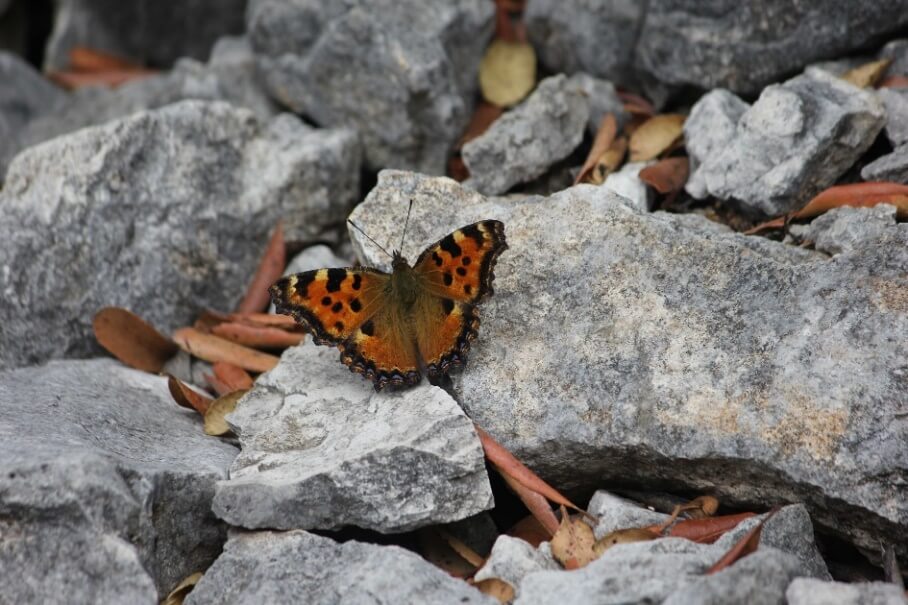
At Mount Roudi of Aenos National Park, dark spots on the stony ground betray some of the fanciest butterflies’ species. The lower surface of Nymphalis polychloros wings is black colored with dark lines and so when the butterfly keeps the wings closed seems black (Figure 8). Butterfly’s characteristic reaction when someone gets very close, is to open and close the wings in a flash, so that appear the amazing colors of the upper surface of the wings. Multiple black "eyes" decorate its four wings with blue and black areas in orange background (Figure 8). In this way butterfly gets "transformed" by the spreading of its wings, into a terribly dangerous animal with threatening "eyes"! When the invader (usually a bird) sees it, it gets surprised, feels to be in danger from this unusual animal and flies away, thus allowing butterfly to escape from danger of the bird predator.
Natural enemies, however, are not the only threat for butterflies living in Kefalonia. The degradation of Kefalonian Fir forest in Aenos National Park, the reduction of biodiversity, the abandonment of traditional crops, fires, the use of insecticides and poaching are the most important threats for butterflies. Butterflies are under protection, especially the rare or endemic species sought after by collectors, according to the provisions of the Presidential Decree 67/1981 "About the protection of native flora, etc."

Today in Greece live at least 3.049 diurnal and nocturnal species of the Lepidoptera family. Diurnal species comprise some Heterocera (moths) and all the Rhopalocera (butterflies). Butterflies count at least 235 species (Pamperis 2009). The composition of Kefalonia Lepidoptera is directly connected to the geological history of the island. Many entomologists describe butterflies as "living fossils", because they seem to transfer elements of geological history from the past to recent years.
To date butterflies in Kefalonia have been studied to a satisfactory degree. The first study of Kefalonian Lepidoptera was made by Gaskin (1996), who recorded 35 species throughout Kefalonia. The most detailed study of Kefalonian insect fauna has been accomplished by Efthymiatou-Katsouni (2006), who has recorded 35 Lepidoptera species. Besides, Maroulis & Xanthakis (2015) have recently confirmed in Kefalonia the existence of 31 species of butterflies from the areas of Paliki and Aenos National Park. Finally, Pamperis (2009) who is a butterfly photographer and author of the excellent book "The Butterflies of Greece" told us (personal communication) that 63 species endemic to Kefalonia belong to five large families: Papilionidae (4 species), Pieridae (12 species), Lycaenidae (17 species), Nymphalidae (23 species) and Hesperiidae (7 species). Among Kefalonian butterflies, species Hipparchia fatua (Figure 9) and Hipparchia volgensis delattini are endemic to Europe. In addition, species Pseudophilotes vicrama, Hipparchia fagi and Hipparchia statilinus are endangered according to the International Union for Conservation of Nature (IUCN - NT Index: Near Threatened). The complete list of Kefalonian butterflies is presented in the following Table I.
Table Ι. List of Butterflies species detected in Kefalonia island
|
Α/Α |
Species |
|
PAPILIONIDAE |
|
|
1 |
Iphiclides podalirius (Linnaeus, 1758) |
|
2 |
Papilio machaon (Linnaeus, 1758) |
|
3 |
Papilio alexanor (Esper 1799) |
|
4 |
Zerynthia polyxena (Denis & Schiffermüller, 1775) |
|
PIERIDAE |
|
|
5 |
Aporia crataegi (Linnaeus, 1758) |
|
6 |
Pieris brassicae (Linnaeus, 1758) |
|
7 |
Pieris rapae (Linnaeus, 1758) |
|
8 |
Pieris ergane (Geyer, 1828) |
|
9 |
Pontia edusa (Fabricius 1777) |
|
10 |
Euchloe ausonia (Hubner, 1805) |
|
11 |
Anthocharis cardamines (Linnaeus, 1758) |
|
12 |
Colias crocea (Geoffroy, 1785) |
|
13 |
Gonepteryx rhamni (Linnaeus, 1758) |
|
14 |
Gonepteryx cleopatra (Linnaeus, 1767) |
|
15 |
Gonepteryx farinosa (Zeller, 1847) |
|
16 |
Leptidea sinapis (Linnaeus, 1758) |
|
LYCAENIDAE |
|
|
17 |
Danaus chrysippus (Linnaeus, 1758) |
|
18 |
Neozephyrus quercus (Linnaeus, 1758) |
|
19 |
Satyrium ilicis (Esper, 1779) |
|
20 |
Satyrium spini (Schiffermüller, 1775) |
|
21 |
Callophrys rubi (Linnaeus, 1758) |
|
22 |
Lycaena flaeas (Linnaeus, 1761) |
|
23 |
Lampides boeticus (Linnaeus, 1767) |
|
24 |
Leptodes pirithous (Linnaeus, 1767) |
|
25 |
Celastrina argiolus (Linnaeus, 1758) |
|
26 |
Cupido minimus (Fuessly, 1775) |
|
27 |
Glaucopsyche alexis (Poda, 1761) |
|
28 |
Pseudophilotes vicrama (Moore, 1865) |
|
29 |
Aricia agestis (Denis & Schiffermuller, 1775) |
|
30 |
Polyommatus icarus (Rottemburg, 1775) |
|
31 |
Polyommatus thersites (Cantener, 1835) |
|
32 |
Cacyreus marshalli (Butler, 1897) |
|
33 |
Charaxes jasius (Linnaeus, 1767) |
|
NYMPHALIDAE |
|
|
34 |
Limenitis reducta (Staudinger, 1901) |
|
35 |
Nymphalis antiopa (Linnaeus, 1758) |
|
36 |
Nymphalis polychloros (Linnaeus, 1758) |
|
37 |
Vanessa atalanta (Linnaeus, 1758) |
|
38 |
Vanessa cardui (Linnaeus, 1758) |
|
39 |
Polygonia egea (Cramer, 1775) |
|
40 |
Argynnis paphia (Linnaeus, 1758) |
|
41 |
Issoria lathonia (Linnaeus, 1758) |
|
42 |
Melitaea didyma (Esper, 1778) |
|
43 |
Melanargia larissa (Geyer, 1828) |
|
44 |
Hipparchia syriaca (Staudinger, 1871) |
|
45 |
Hipparchia fagi (Scopoli, 1763) |
|
46 |
Hipparchia senthes (Fabricius, 1807) |
|
47 |
Hipparchia volgensis delattini* (Mazochin-Porshnjakov, 1952) |
|
48 |
Hipparchia fatua* (Freyer, 1844) |
|
49 |
Hipparchia statilinus (Hufnagel, 1766) |
|
50 |
Maniola jurtina (Linnaeus, 1758) |
|
51 |
Hyponephele lupina (Costa, 1836) |
|
52 |
Coenonympha pamphilus (Linnaeus, 1758) |
|
53 |
Pararge aegeria (Linnaeus, 1758) |
|
54 |
Lasiommata megera (Linnaeus, 1767) |
|
55 |
Lasiommata maera (Linnaeus, 1758) |
|
56 |
Kirinia roxelana (Cramer, 1777) |
|
HESPERIIDAE |
|
|
57 |
Spialia orbifer (Hübner, 1823) |
|
58 |
Muschampia proto (Ochsenheimer, 1816) |
|
59 |
Carcharodus alceae (Esper, 1780) |
|
60 |
Carcharodus orientalis (Reverdin, 1913) |
|
61 |
Thymelicus acteon (Rottemburg, 1775) |
|
62 |
Thymelicus sylvestris (Poda, 1761) |
|
63 |
Gegenes pumilio (Hoffmannsegg, 1804) |
* Butterfly species endemic to Europe
The recording of Lepidoptera in Kefalonia and especially in Aenos National Park was carried out by Dr Michail Xanthakis, Coordinator of N.E.C.C.A. in collaboration with the Supervision/Guard Personnel of N.E.C.C.A.. The recording of butterflies in Palliki was carried out by Christos Maroulis, Wild Life photographer and Automation Engineer. These recordings leaded to the creation of a poster entitled: "Butterflies of Aenos National Park" in the framework of a Subproject implemented by N.E.C.C.A. entitled: "Printing of Printed & Digital Material", Contractor "Katagramma GP" (Fig. 10). The registration of butterfly population in Kefalonia was implemented by own means and financed by credits of the project 2011ΣΕ07580012, about the integrated Act: “Protection and Conservation of Biodiversity of Aenos National Park” of the Operational Program for the ENVIRONMENT AND SUSTAINABLE DEVELOPMENT 2007-2013.
The above article was published in the magazine "The Kefalonian Progress" Period B, issue 17, January - March 2016
The photos come from the file photo archive of the Natural Environment and Climate Change Agency and the Wildlife Photographer Christos Maroulis that we warmly thank.